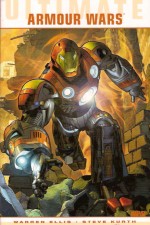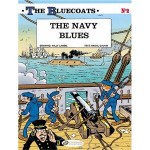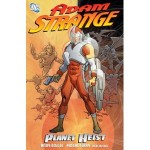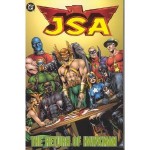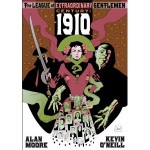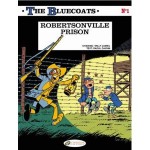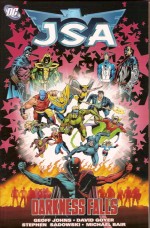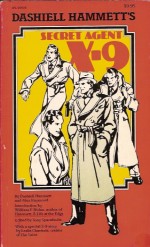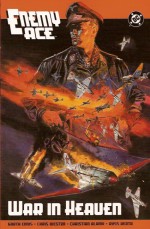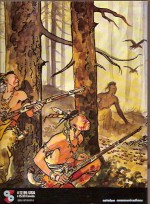
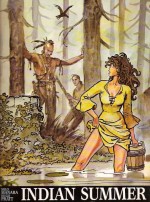
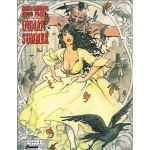
By Milo Manara & Hugo Pratt, translated by Jeff Lisle (Catalan Communications)
ISBN: 0-87416-030-2-8
Hugo Eugenio Pratt (June 15th 1927 – August 20th 1995) was one of the world’s paramount comics creators, and his inventions since ‘Ace of Spades’ (whilst still a student at the Venice Academy of Fine Arts) in 1945 were both many and varied. His most famous character, based in large part on his own exotic early life, is the mercurial soldier -Â perhaps sailor would be more accurate – of fortune, Corto Maltese.
After working in both Argentinean and English comics for years Pratt returned to Italy in the 1960s. In 1967 he produced a number of series for the monthly comic Sgt. Kirk. In addition to the Western lead character, he created a pirate strip Capitan Cormorand, the detective strip Lucky Star O’Hara, and a moody South Seas adventure called Una Ballata del Mare Salato (A Ballad of the Salty Sea). The magazine folded in 1970, but Pratt took one of Ballata‘s characters to the French weekly, Pif, before eventually settling into the legendary Belgian comic Tintin. Corto Maltese proved as much a Wild Rover in reality as in his historic and eventful career.
However a storyteller of such vast capabilities as Pratt was ever-restless, and as well as writing and illustrating his own tales he has written for other giants of the industry. In 1983 he crafted a steamy tale of sexual tension and social prejudice set in the New England colonies in the days before the Salem Witch Trials.
Tutto ricominciò con un’estate Indiana (released and known as Indian Summer – although a more appropriate and illustrative translation would be “All things begin again with an Indian Summerâ€) was brought to stunning pictorial life by fellow Italian graphic raconteur Milo Manara.
Maurilio Manara (born September 12th 1945) is best known for his wry, controversial erotica – but that’s more an indicator of the English-speaking comics market than any artistic obsession; an intellectual, whimsical craftsman with a dazzling array of artistic skills ranging from architecture, product design, painting and of course an elegant, refined, clear-clean line style with pen and ink.
He studied painting and architecture before becoming a comic artist in 1969, beginning with the Fumetti Neri series Genius, worked on the magazine Terror and in 1971 began his erotic career illustrating Francisco Rubino’s Jolanda de Almaviva. In 1975 his first major work Lo Scimmiotto (‘The Ape‘ – a reworking of the Chinese tales of the Monkey King) was released.
By the end of the decade he was working for the Franco-Belgian markets where he is still regarded as a first-rank creator. It was while working for Charlie Mensuel, Pilote and L’Écho des savanes that he created his signature series HP and Giuseppe Bergman – which saw print in A Suivre. The “HP†of the title is his good friend Hugo Pratt…
New England in the 17th century: the Puritan village of New Canaan slowly grows in placid, if uneasy, co-existence with the natives who have fished and hunted these coastal regions for centuries. When young Shevah Black is raped by two young Indians, outcast Abner Lewis kills them both. Taking the “ruined†girl back to his mother’s cottage in the woods the girl meets the entire family – mother Abigail, siblings Jeremiah, Elijah and Phyllis – a whole brood of damned sinners banished by her uncle the Reverend Pilgrim Black.
The mother was once a servant in the Black household, but has lived in the woods for twenty years, ever since Pilgrim Black’s father raped her. When Abigail fell pregnant she was cast out for her sin. Her face bears a sinner’s brand. Aided by the Indians the mother built a cabin, and over the years had three further children. Her progeny are all wild creatures of nature; healthy, vital and with many close ties both to the natives (from choice) and the truly decadent Black family (by sordid, unwelcome history).
Now blood has spilled and passions are roused: none of those ties can prevent a bloodbath, and as the day progresses many dark secrets come to light as the intolerance, hypocrisy and raw, thwarted lust of the upstanding Christians leads to an inexorable clash with the Indians – by far the most sensible and decent individuals in the place – with the pitifully isolated, ostracized and alienated Lewis clan stuck in middle and betrayed by both…
Beautiful, disturbing and utterly compelling, this thoroughly adult examination of sexual tension, attitudinal eugenics and destructive, tragic love is played out against the seductive heat and primitive glories of a natural, plentiful paradise which only needs its residents to act more like beasts and less like humans to achieve a perfect tranquility. Sadly, every Eden has serpents and here there are three: religion, custom and pride…
Pratt’s passion for historical research is displayed by the graphic afterword in which he not only cites his extensive sources – including a link to Nathaniel Hawthorne’s classic novel The Scarlet Letter – but adds some fascinating insights and speculations on the fates of the survivors of New Canaan massacre…
Although there is a 1994 NBM edition readily available I’m reviewing from my 1986 Catalan copy principally because I own that one, but also because the Catalan copy has a magnificent four-page foldout watercolour cover (which I couldn’t fit onto my scanner no matter how I tried) and some pretty amazing sketches and watercolour studies gracing Javier Coma’s insightful introduction.
This is a classic tale of humanity frailty, haunting, dark and startlingly lovely. Whatever version you find, you must read this superb story.
© 1986 Milo Manara & Hugo Pratt. English language edition © 1986 Catalan Communications. All Rights Reserved.

